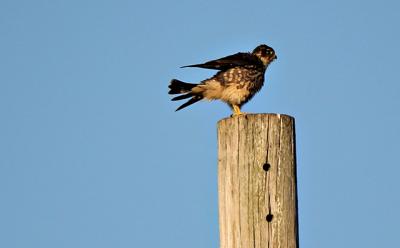Nature Notes: Winged Hunters

The winter birds are here until March and April. It’s time to stock the feeders for the long winter haul. Most of us who feed the birds will be carefully watching, identifying, and counting, and so will a bird or two whose powers of observation far outstrip our own — those pesky hawks with the sharp beaks and vice-grip talons.
When I came back from living on the West Coast for 15 years to teach at Southampton College in 1974, there weren’t many hawks around during the winter. The feeder birds had it easy. They could relax and enjoy their seeds and suet and didn’t have to continually look over their shoulders.
The 1960s may have been the low point for all New York State birds of prey. The osprey population had plummeted so far that they were considered endangered, legally so after the Nixon administration gave us the Endangered Species Act. DDT and other pesticides were the chief culprits causing the lows in the hawk populations, but hunters, too, were to blame. New York State was one of the first to pass a law protecting hawks, falcons, owls, eagles, and ospreys.
Bit by bit through the years the birds of prey have made a comeback, some of them reaching population levels observed around the time of World War II. The ospreys and red-tailed hawks became common breeders, the others, such as the Cooper’s and sharp-shinned hawks, are following in their tracks. Peregrine falcons have been nesting on bridges across the rivers on both sides of Manhattan Island for almost 20 years now. Three bald eagle pairs are nesting and rearing young on Long Island.
Red-tails are mostly after squirrels and rabbits, not too interested in feeder birds. Screech owls hang around the feeders at night in hopes of getting a mouse or rat. Goodness knows, there are more than enough mice and rats around to feed an army of owls and feral cats.
The Cooper’s and sharp-shinned hawks and Merlins are the most common daytime predators of small and medium-size birds at feeders. They take up territories in neighborhoods with lots of feeders and travel the route, showing up at the line of feeders at different times of day. Some feeders are so well stocked and so much out in the open that a given hawk can almost stay in one place for most of the day to nail a mourning dove or blackbird.
Many of our year-round birds — chickadees, nuthatches, titmice, woodpeckers, and blue jays — have already formed mixed feeder flocks that are semi-nomadic, hitting this and that woodland, pastoral, or residential feeder location in the course of a day. Very often these are accompanied by blue jays, the sentries, always on the lookout for feathered predators and ready to utter their screechy calls upon seeing one.
There are a few things a homeowner can do to cut down on losses when putting up a feeding station. Instead of putting it clear out in the open in plain sight of any overhead passerby, put it near bushes so that the birds can take cover quickly if attacked. When it comes to escaping hawks, songbirds are no match in flight, and, if given the chance, will dart into thickets to escape those sharp talons.
Keep the feeder away from windows — feeding birds chased by hawks will try to pass through a window thinking it to be an opening and clunk themselves on the head. Unless you are there in a few seconds to pick up the dazed bird and put it in the box with a towel over it until it recovers, the hawk will swoop down and take it.
Come spring, hawks and owls lay eggs in nests, incubate the eggs, and raise hawklets and owlets. They burn up a lot of energy during the winter and need a daily source of energy to keep them fit until spring. As a famous Indian guru once said, “hunters hunt.” He might have easily substituted birds of prey for hunters; it’s in their genes.
Larry Penny can be reached via email at [email protected].
